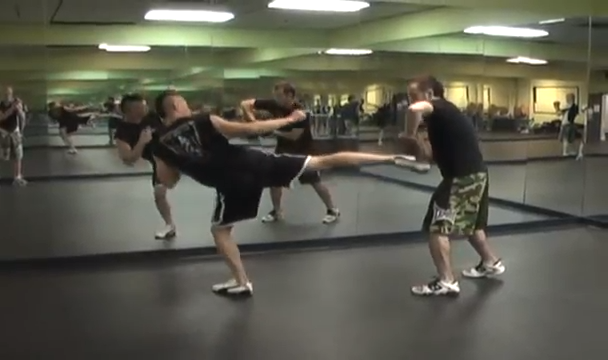
Hey Everybody!
Today’s kickboxing basics topic is largely going to be addressing proper form so you can throw the perfect hook kick or roundhouse kick.
This is going to be a complete breakdown of the hook kick in kickboxing. The hook kick is sometimes called a roundhouse kick in some kickboxing circles.
Hand positioning
Kickboxing students as they execute the hook kick, fail to realize the importance of keeping their hands up to protect against possible counter attacks when they’re sparring. This is a Kickboxing basics principle that every student needs to keep in mind.
Kickboxing students with drop their hands in an attempt to increase the power of their kicks. As this is true, it is more prudent for kickboxing students to keep their hands up and reduce their kicking power.
Head position
When executing a hook kick, new students to kickboxing will typically keep their head up right.
This is a mistake. When doing a hook kick, the head must tilt back as the kicking leg raises. Let’s use a seesaw as an analogy. As one end goes up, the other end goes down. Think of your body acting like a canter-lever. As your foot comes up, your head must go down.
Kickboxing students make the mistake of keeping their head upright in an attempt to keep their boxing stance. Keeping an upright boxing stance while executing a kick will only put them in range for an easy punch counter attack and will only lessen the power and reach of their kick.
Lean back as you execute your kicks and you’ll instantly find in increase in the power.
Hip position- show your butt
For the hook kick to have follow through and power, kickboxing students need to turn their hip so that their training partner can see their butt. If your training partner can’t see your butt then there’s not enough follow through and there’s not enough hip rotation. Focus on showing your training partner your butt and you’ll have a much more powerful hook kick.
One fluid motion
Many kickboxing students attempt to do the hook kick in two segregated parts. Kickboxing students will first lift the knee; and then, secondly, extend the leg.
As an initiatial training method to introduce new students to kickboxing, this can be a helpful way to train the hook kick.
But for maximum power and to make your kick non-telegraphic, it is best to execute the kick as one fluid motion.
Turning your foot too much
Whenever you’re executing a hook kick, your knees need to be out and up.
Many kickboxing students drop their knees and turn their knees in as they kick. This is a mistake. This is typically born from students over steering the hip rotation.
Aim the kick with your big toe and not with your pinky toe. But be sure to always strike with the last half of your shin. By aiming kicks with the big toe, kickboxing students will ensure a higher degree of safety for their hips and knees.
Show the bottom of your shoe
When executing the hook kick, many kickboxing students simply elevate their kicking leg straight up. This is a mistake. Kickboxing students need to lift and turn their leg as well.A general rule is to show the bottom of your shoe out to the wall as you’re throwing a hook kick.
Hip before heel
In my school, we often stress the importance of reach and extension when executing the hook kick.
Kickboxing students often keep their hip behind the heel of the planted foot as they’re throwing a hook kick.
This is a mistake. To maximize the distance and the power of the hook kick, kickboxing students need to bring their hip in front of the heel of the planted foot.
Turn your heel
Turning your heel is absolutely the most critical component with the hook kick. I can’t emphasize enough the importance of heel rotation when it comes to the follow through and power for the hook kick.
Kickboxing students need to turn their planted foot so that the heel points to the target.
Thanks eveybody!
I hope you’ll find this Kickboxing basics tutorial on the hook kick helpful. If you prefer to call the hook kick a roundhouse kick, that’s cool with me too 🙂



